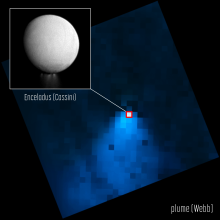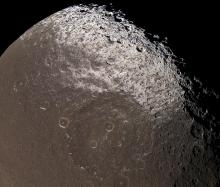Listen to today's episode of StarDate on the web the same day it airs in high-quality streaming audio without any extra ads or announcements. Choose a $8 one-month pass, or listen every day for a year for just $30.
You are here
Moon and Saturn
Saturn’s rings are beautiful to look at. For scientists, they’re also valuable instruments — they provide a glimpse deep inside the giant planet.
The main rings span about three-quarters of the distance from Earth to the Moon. They consist mainly of ice — from tiny grains to big boulders — with a smattering of dust and rock.
The Cassini spacecraft studied the rings as it orbited Saturn for more than a decade. It found that the rings are constantly changing. And some of those changes are caused by what’s happening inside Saturn. Motions deep within the planet cause subtle changes in Saturn’s gravitational and magnetic fields.
A few years ago, scientists used those changes to measure the length of Saturn’s day. That had been hard to pin down because Saturn doesn’t have a solid surface. But Cassini revealed waves rippling through the rings. The waves told scientists that a day on Saturn lasts a little more than 10 and a half hours.
And this year, scientists used a wave pattern seen in one of the rings to suggest that Saturn’s core is mushy. It contains a lot of rock and metal, but it’s mixed with hydrogen and helium, which make up most of the planet. That would make the core gooey and poorly defined, like a ball of melting cheese — a discovery made possible by Saturn’s rings.
And Saturn is easy to find early this evening. It looks like a bright star quite close to the Moon. Its rings are visible through just about any telescope.
Script by Damond Benningfield





